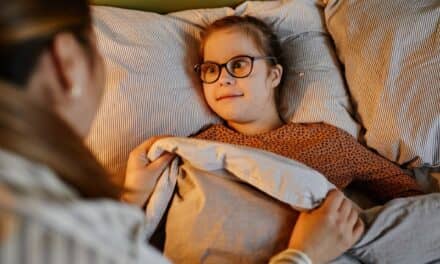A recently published literature review provides guidance on screening, diagnoses, and treatment for a common symptom.
By Lisa Spear
A child’s sleepiness may seem harmless, but when daytime sleepiness becomes excessive, children can miss important developmental milestones and may even face long-term health consequences that can stay with them well into adulthood. And during times of stress—including during the current global health crisis—sleep troubles in children and adolescents may become magnified.
In a recent Clinical Pediatrics journal article, researchers review how excessive daytime sleepiness (EDS) manifests in the pediatric population. The article is a literature review of pediatric EDS, which could serve as a reference for clinicians who want to learn more about how to screen, diagnose, and treat children at a time when they may be seeing an influx of patients with sleep concerns.
According to the review, sleep problems that can cause excessive daytime sleepiness are present in about 25% to 40% of kids and adolescents, encompassing behavioral, neurologic, and respiratory disorders.
“This is a significant issue in the pediatric population,” says Judith Owens, MD, MPH, director of the Center for Pediatric Sleep Disorders at Boston Children’s Hospital at Waltham.
While there is no research yet to confirm an influx in pediatric sleep problems during the current global health crisis, Owens says this may be the case. “During the last six weeks, I’ve had a lot of adolescents in particular with complaints of daytime sleepiness that seem to be exasperated during the pandemic and the stay-at-home orders,” says Owens, professor of neurology at Harvard Medical School.
“How that plays out exactly, I’m not quite sure. It has been interesting to see, at least anecdotally, that there seems to be more concern,” she says. “But it is hard to know whether this represents a real increase.” Another factor, she says, is many sleep clinics have expanded their telemedicine services and now parents may have more access to care for their children.
Parents may also be becoming more aware of preexisting sleep issues that their children are facing since adults are now staying at home more and are able to witness their child’s daytime sleepiness.
While many teenagers are sleepy for reasons other than any underlying medical conditions, including early school start times and poor bedtime habits, Owens says it’s important for clinicians to take the time to weed out cases that are clinically significant.
“The consequences are even more concerning in adolescents because we know that daytime sleepiness is linked to cognitive changes, particularly executive functions and problem solving. That part of the brain, the prefrontal cortex, is undergoing very rapid development during the adolescent years, so it is highly vulnerable to the effects of insufficient sleep and daytime sleepiness,” says Owens.
Is It Fatigue or Excessive Sleepiness?
It’s not always easy to see the difference between fatigue and EDS, but there are a number of screening tools to guide clinicians to make the distinction. Well-validated questionnaires for pediatric sleep problems include the BEARS 5-item questionnaire and the Children’s Sleep Habits Questionnaire, among others.
The literature review also recommends other tools used specifically to screen for EDS in the pediatric population, including the Pediatric Daytime Sleepiness Scale and Modified Epworth Sleepiness Scale for Children and Adolescents.
A parent-recorded sleep diary can also help in pinning down exactly why a child is experiencing drowsiness. The article suggests that parents should be advised to document their child’s sleep and wake times over a two-week period, which can avoid potentially inaccurate histories recalled during visits in the physician’s office.
Presentation of Daytime Sleepiness in Pediatrics
According to the article, EDS looks different in younger children than it does in adolescents. While adolescents may complain that they are tired or sleepy or doze off, EDS in prepubescent children can manifest with behavioral problems.
A hallmark of daytime sleepiness in young children is hyperactivity and impulsivity. Children may also exhibit oppositional or aggressive behaviors. For young children and adolescents, EDS can lead to the decline of many daily functions, including a poor academic performance as well as mood disturbances.
“Daytime sleepiness cuts across many different domains that really determine the quality of life for children,” says Owens.
Difficulty waking up in the morning and falling asleep during the day in inappropriate circumstances may be attributed to EDS. The propensity to sleep longer than usual when given the opportunity, including on weekends, is also an important sign of chronic insufficient sleep, the review says.
“I tell families, ‘If your child has difficulty waking up at the time that they need to get up in the morning either for school or for anything else, that is a bit of a red flag,’” says Owens.
Young children with EDS may also present as inattentive and unfocused, or withdrawn and isolated because they skip social gatherings because of their sleepiness. Since alertness in school-aged children is normally high, clinicians should have a low threshold for investigating concerns of sleepiness in this age group, the review says.
Long-term Health Outcomes and Treatment
After daytime sleepiness is confirmed, the review suggests that providers start with behavioral and nonpharmacologic approaches by advising the patients and their families on good sleep hygiene practices. Pharmacotherapy options can be explored as an adjunct if behavioral interventions are not successful.
Children with obstructive sleep apnea may see improvements from adenotonsillectomy, weight reduction, and continuous positive airway pressure.
If EDS is not treated and properly managed, a child may also experience permanent negative health outcomes. An inflammatory response can impact the cardiovascular system. Insufficient sleep is also linked to an increase risk of obesity and hypertension, says Owens.
“There’s not only a short-term effect, but potentially a longer effect as well.”
Lisa Spear is the associate editor of Sleep Review.
Reference
Owens J, Babcock D, Weiss M. Evaluation and treatment of children and adolescents with excessive daytime sleepiness. Clinical Pediatrics. 2020 March. 59 (4-5): 340-51.





